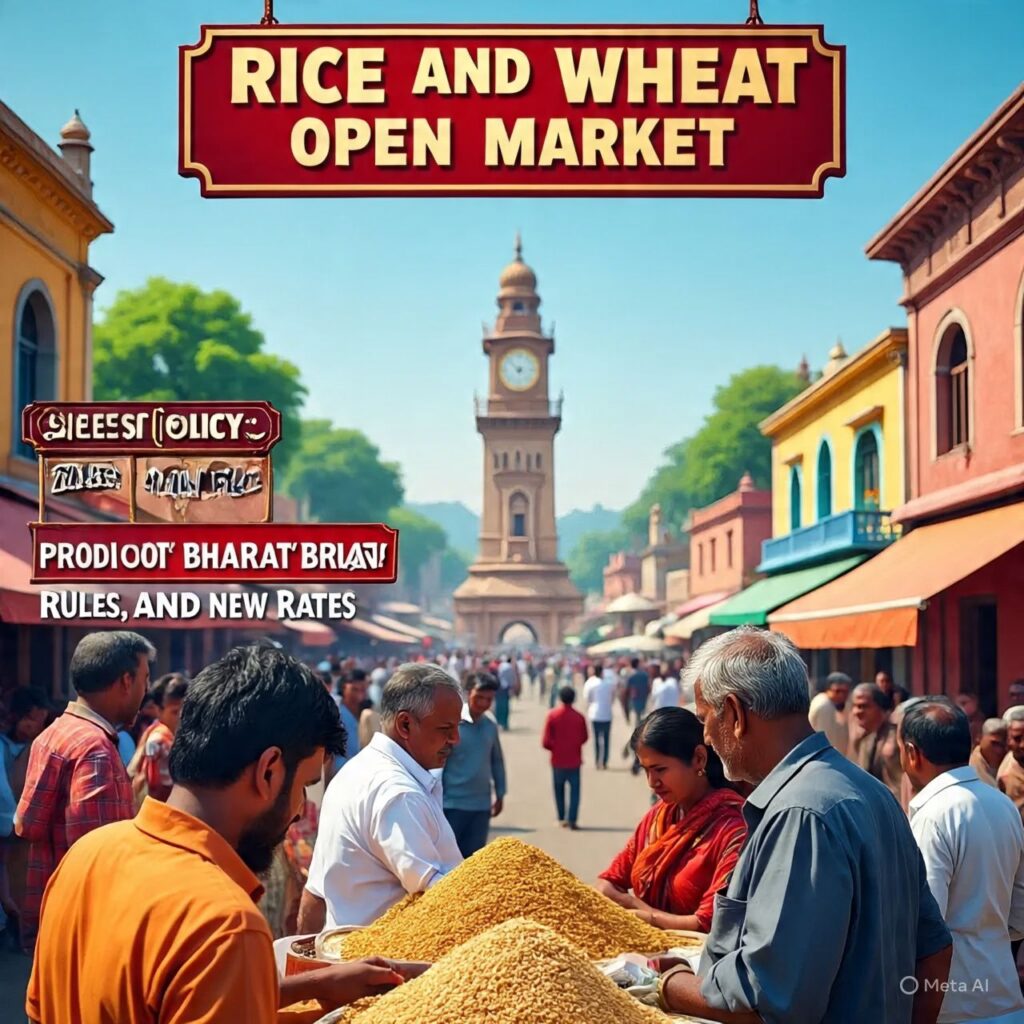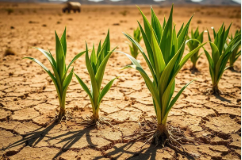
In a major step towards managing food grain reserves and ensuring efficient distribution, the Government of India has rolled out a new notification revising the Open Market Sale Scheme (OMSS) for wheat and rice. The updated policy outlines fresh guidelines for reserve prices, new categories, special provisions for ethanol production, and a clearer framework for the use of the government’s ‘Bharat’ rice brand.
This comprehensive approach is intended to maintain a balance between food security, fair market operations, and emerging demands like biofuel production. Here’s an in-depth look at what’s changing and how it will impact various stakeholders — from farmers and millers to ethanol producers, cooperatives, and the general public.
Key Highlights at a Glance
- 52 lakh tonnes of rice has been earmarked exclusively for ethanol production in the 2025–26 supply year (November–October).
- New minimum reserve prices have been set for wheat and rice for different buyer groups.
- Introduction of a ‘broken rice’ category specifically for ethanol and distillery use.
- Updated pricing and supply norms for the sale of rice under the government’s ‘Bharat’ brand, managed through select cooperatives only.
- Institutional buyers and state agencies will get revised rates and quantities under the new OMSS guidelines.
Ethanol: A Push for Green Fuel with Grain Diversion
A major focus of the updated OMSS policy is the continued diversion of surplus rice stock towards the production of ethanol — an important part of India’s biofuel strategy. The government has confirmed that for the 2025–26 supply year, 52 lakh metric tonnes of rice will be set aside for this purpose, the same as in the previous year.
This rice will mainly come from older or broken stock, as the policy emphasizes the use of lower-grade rice, such as broken rice, to ensure food-grade supplies remain unaffected. The price for ethanol-use rice has been revised to ₹2,320 per quintal, up from the previous ₹2,250 per quintal.
As per the new rules, rice allocated for ethanol will be sold to approved distilleries via e-auction or direct allocation, depending on eligibility. The focus on using broken or aged rice aligns with the government’s goal to manage stock efficiently while boosting domestic ethanol output, which supports the broader aim of blending green fuel with petrol and reducing fossil fuel imports.
Introducing a Dedicated Broken Rice Category
To streamline supply for the distillery sector, the new policy adds a formal category for broken rice under the Rice Milling Transformation Scheme. This move creates a clearer channel for millers to sell lower-quality rice directly for industrial purposes.
Private buyers can now purchase broken rice through e-auctions at the newly set reserve price of ₹2,320 per quintal starting November 1, 2025. The primary buyers will be distilleries converting rice starch into ethanol, which will later be blended with conventional fuel.
This dedicated stream ensures better stock management, minimizes wastage, and optimizes the use of rice grains that may not be suitable for direct human consumption but are still valuable for industrial applications.
Wheat Reserve Prices Revised Upwards
Alongside rice, the government has adjusted the reserve price for wheat sold under OMSS. For all buyer categories, wheat will now be sold at a base price of ₹2,550 per quintal, up from last year’s range of ₹2,300–2,325 per quintal.
This increase aligns with the government’s focus on ensuring minimum support prices (MSP) for farmers remain viable and reflect changing market conditions. The revised rate also aims to maintain stable supplies in the open market, balancing farmers’ interests with consumer needs.
A Big Shift for the ‘Bharat’ Brand Rice
A unique aspect of the new policy is the update on how rice under the government’s ‘Bharat’ brand will be sold. The ‘Bharat’ brand was launched to provide affordable, good-quality grains to consumers through government-backed cooperatives.
According to the new guidelines, only three designated cooperative bodies — NAFED (National Agricultural Cooperative Marketing Federation), NCCF (National Cooperative Consumers’ Federation), and the Kendriya Bhandar (Central Store) — will be authorized to sell rice under the ‘Bharat’ label. The rate has been set at ₹2,480 per quintal for the period from November 1, 2025, to June 30, 2026.
The cooperatives can sell this rice through physical stores, mobile vans, e-commerce platforms, and leading retail chains. However, from July 1, 2026, the existing subsidy of ₹200 per quintal, which these cooperatives currently enjoy, will be discontinued — likely increasing operational costs for these institutions.
Importantly, private mills and traders are explicitly barred from selling rice under the ‘Bharat’ brand, preserving the integrity and trust that this public label represents.
Institutional Buyers: Updated Prices and Conditions
Institutional buyers, including large canteens, government-backed kitchens, and approved organizations, can now buy rice from the Food Corporation of India (FCI) at ₹2,480 per quintal starting November 1 — a slight increase from the previous ₹2,400 per quintal.
State governments, their agencies, and community kitchens will benefit from a fixed price of ₹2,320 per quintal — but with a catch: the total quantity available for such buyers has been reduced from 36 lakh tonnes to 32 lakh tonnes. They can buy this rice directly without participating in the e-auction, offering a simpler procurement process for public distribution schemes and welfare initiatives.
Updated Rates for Broken Rice Variants
To add clarity for industry-specific buyers, the policy now defines reserve prices for different grades of broken rice. For example:
- 10% broken rice will have a reserve price of ₹3,090 per quintal.
- 25% broken rice will be sold at ₹2,890 per quintal.
These figures include transportation costs, ensuring buyers have clear landed pricing. However, for wheat, transport expenses remain separate.
Balancing Surplus Stocks, Market Rates, and Food Security
The government’s updated OMSS policy addresses three critical priorities: managing surplus buffer stocks, stabilizing open market prices for essential staples, and supporting alternative uses like ethanol to reduce fossil fuel dependency.
By using older or lower-grade rice for ethanol production, the policy relieves storage pressure on FCI warehouses and prevents unnecessary wastage. It also indirectly helps stabilize grain prices in the domestic market by adjusting how and where surplus stock is deployed.
Why This Matters: Biofuel Push Meets Food Economy
India’s National Biofuel Policy sets ambitious blending targets, with ethanol playing a crucial role. Grain-based ethanol — especially from surplus rice and maize — has become an important part of this plan. It helps reduce the oil import bill, supports the rural economy, and aligns with India’s commitments to sustainable energy.
At the same time, the government must ensure that using food grains for industrial purposes does not affect domestic food security. By channeling only broken or lower-quality rice for ethanol and setting clear reserve prices for food-grade stocks, the new OMSS policy tries to strike this delicate balance.
The Role of Cooperatives: Trust and Accessibility
The ‘Bharat’ brand, managed by cooperatives like NAFED, NCCF, and Kendriya Bhandar, plays a vital role in making reasonably priced staples accessible to millions. By restricting this branding exclusively to approved cooperatives, the government aims to prevent misuse, price manipulation, and counterfeit branding in the retail market.
This system allows consumers to buy rice at stable, controlled rates while ensuring that margins go to trusted cooperatives that reinvest in farmer welfare and rural infrastructure.
Challenges Ahead
While the policy has clear intentions, its success will depend on smooth implementation. Ensuring that private traders do not misuse broken rice channels, maintaining quality standards for ethanol rice, and monitoring that only eligible cooperatives use the ‘Bharat’ label are all important factors.
Additionally, the removal of the ₹200-per-quintal subsidy after June 2026 may require cooperatives to adjust their pricing or operational efficiency to keep ‘Bharat’ rice affordable.
How Farmers Benefit
Farmers stand to gain indirectly through steady demand for surplus grains, improved price realization for older stocks, and additional income streams if broken rice fetches fair industrial rates. The increased reserve price for wheat will also give wheat growers confidence that minimum prices remain aligned with their input costs.
A Structured Policy for a Stable Future
Overall, the new OMSS policy provides a clearer, more transparent framework for food grain sales in India’s open market. It supports multiple objectives:
- Easing warehouse stock burden.
- Stabilizing open market grain prices.
- Supporting India’s ethanol blending roadmap.
- Protecting the integrity of the ‘Bharat’ brand.
- Offering clear, fair pricing structures for various buyer groups.
- Ensuring that surplus or substandard rice is put to productive use.
Conclusion
India’s food grain supply chains are complex, balancing farmer welfare, consumer needs, export targets, and now, green fuel ambitions. The updated OMSS policy is an example of how the government is trying to align traditional agriculture with modern sustainability goals.
By combining robust oversight, modern pricing, industrial linkages, and trusted cooperatives, the policy aims to build a resilient, flexible system that keeps India’s granaries stocked, farmers secure, and consumers supplied — while also helping the country shift towards cleaner, domestic energy.
The success of this policy will depend on collaboration among FCI, ethanol producers, cooperatives, millers, state governments, and millions of farmers across the country. If implemented effectively, it promises to keep India’s food economy strong and its green fuel ambitions on track.














